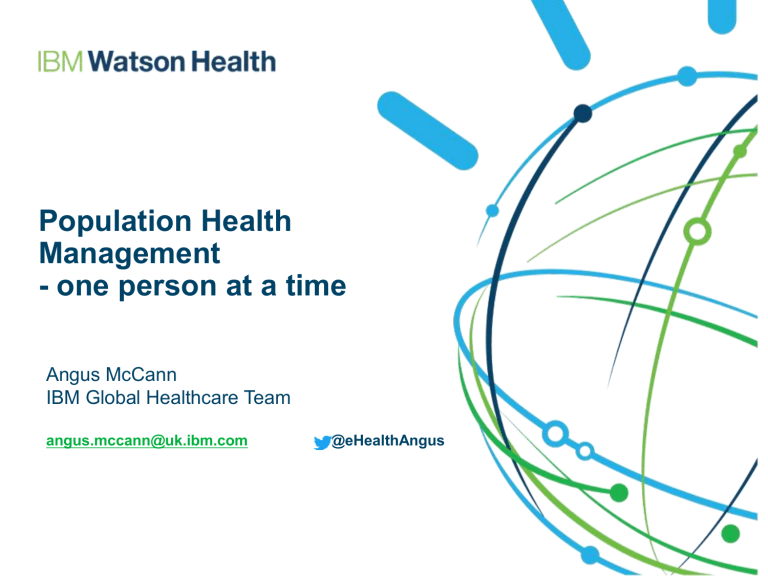
Population Health Management - one person at a time Angus McCann IBM Global Healthcare Team angus.mccann@uk.ibm.com @eHealthAngus Spot the ‘patient’… 3 Source: Bipartisan Policy Center, “F” as in Fat: How Obesity Threatens America’s Future (TFAH/RWJF, Aug. 2013) 4 Focusing on sickest does not bend the cost trend 5 One ‘patient’ at a time? Current View 30 Patients Per Day 14 have Chronic Conditions Unknown Health Risks Visits Too Short for Coaching Volume-Based/Episodic New Population View 2500 Patient Population 900 have Chronic Conditions 1100-1250 have Mod-High Health Risk Care enhanced through IT & data Value-Based/Continuous 6 Key facets of population health management • Comprehensive view of ‘health’ – physical, mental, whole person • Early Intervention, Health Promotion and Prevention • Wider determinants of health considered – eg Income maximisation, legal advice, housing, education • Addressing lifestyle behaviours • Use of data • Population stratification / risk prediction • Care pathways defined and used • Self-management • Integration across agencies Well At Risk Acute Self-Limiting Chronic Illness Complex Care Comprehensive view of ‘health’ / wider determinants 8 Population definition / stratification 1. Diabetes stands out with a low overall compliance rate of 38% 2. Significant percent of diabetic patients with A1c rates >9 9 Bring people into the system (appropriately) 11 Automate Team based care – integrated across agencies Patient engagement / self management Identify variance in care by practice Identify variances by practice to target improvement strategies 16 Identify variance by clinician 17 New delivery models require integrated data… 19 20 Medical text analytics Diseases Medications Symptoms Modifiers 21 What really causes heart failure readmissions at Seton The Data We Thought Would Be Useful … Wasn’t • • • 113 candidate predictors from structured and unstructured data sources Structured data was less reliable then unstructured data – increased the reliance on unstructured data New Unexpected Indicators Emerged … Highly Predictive Model Predictor Analysis % Encounters Structured Data % Encounters Unstructured Data Ejection Fraction (LVEF) 2% 74% Smoking Indicator 35% (65% Accurate) 81% (95% Accurate) Living Arrangements <1% 73% (100% Accurate) Drug and Alcohol Abuse 16% 81% Assisted Living 0% 13% 22 Helping the population be healthy Data Driven Every Person has a Plan Team Based Automation to Manage a Population Down to the Individual 23 BCS Health Scotland Conference • Strathclyde University • 11/12 Oct 24 Population Health Management - one person at a time Angus McCann IBM Global Healthcare Team angus.mccann@uk.ibm.com @eHealthAngus




